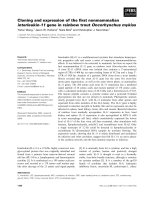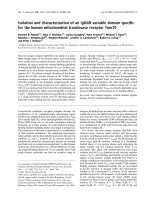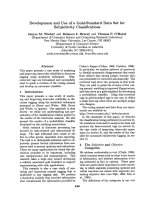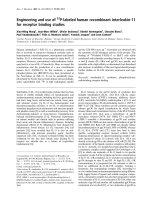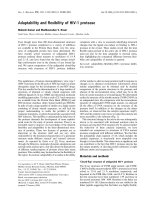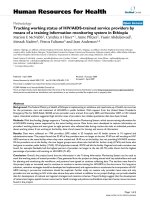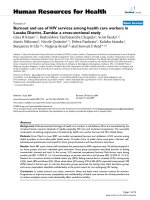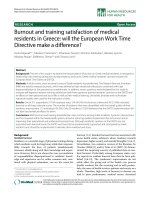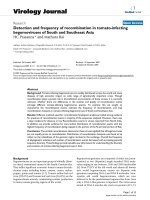báo cáo sinh học:" Burnout and use of HIV services among health care workers in Lusaka District, Zambia: a cross-sectional study" pot
Bạn đang xem bản rút gọn của tài liệu. Xem và tải ngay bản đầy đủ của tài liệu tại đây (264 KB, 10 trang )
BioMed Central
Page 1 of 10
(page number not for citation purposes)
Human Resources for Health
Open Access
Research
Burnout and use of HIV services among health care workers in
Lusaka District, Zambia: a cross-sectional study
Gina R Kruse
1,2
, Bushimbwa Tambatamba Chapula
3
, Scott Ikeda
1,4
,
Mavis Nkhoma
1
, Nicole Quiterio
1,5
, Debra Pankratz
1
, Kaluba Mataka
1
,
Benjamin H Chi
1,6
, Virginia Bond
7,8
and Stewart E Reid*
1,9
Address:
1
Centre for Infectious Disease Research in Zambia (CIDRZ), Lusaka, Zambia,
2
Department of Medicine, Massachusetts General Hospital,
Boston, Massachusetts, USA,
3
Lusaka District Health Management Team, Zambian Ministry of Health, Lusaka, Zambia,
4
Department of Family
and Social Medicine, Montefiore Medical Center, Bronx, New York, USA,
5
Department of Pediatrics, The Bristol Myers Squibb Children's Hospital,
Robert Wood Johnson University Hospital, New Brunswick, New Jersey, USA,
6
Schools of Medicine and Public Health, HIV/AIDS Research in
Africa, Department of Obstetrics and Gynecology, University of Alabama at Birmingham, Birmingham, Alabama, USA,
7
ZAMBART Project,
Ridgeway Campus, Ridgeway, Lusaka, Zambia,
8
Health Policy Unit, Department of Public Health and Policy, London School of Hygiene and
Tropical Medicine, London, UK and
9
School of Medicine, Division of Infectious Disease, University of Alabama at Birmingham, Birmingham,
Alabama, USA
Email: Gina R Kruse - ; Bushimbwa Tambatamba Chapula - ;
Scott Ikeda - ; Mavis Nkhoma - ; Nicole Quiterio - ;
Debra Pankratz - ; Kaluba Mataka - ; Benjamin H Chi - ;
Virginia Bond - ; Stewart E Reid* -
* Corresponding author
Abstract
Background: Well-documented shortages of health care workers in sub-Saharan Africa are exacerbated by the
increased human resource demands of rapidly expanding HIV care and treatment programmes. The successful
continuation of existing programmes is threatened by health care worker burnout and HIV-related illness.
Methods: From March to June 2007, we studied occupational burnout and utilization of HIV services among
health providers in the Lusaka public health sector. Providers from 13 public clinics were given a 36-item, self-
administered questionnaire and invited for focus group discussions and key-informant interviews.
Results: Some 483 active clinical staff completed the questionnaire (84% response rate), 50 staff participated in
six focus groups, and four individuals gave interviews. Focus group participants described burnout as feeling
overworked, stressed and tired. In the survey, 51% reported occupational burnout. Risk factors were having
another job (RR 1.4 95% CI 1.2–1.6) and knowing a co-worker who left in the last year (RR 1.6 95% CI 1.3–2.2).
Reasons for co-worker attrition included: better pay (40%), feeling overworked or stressed (21%), moving away
(16%), death (8%) and illness (5%). When asked about HIV testing, 370 of 456 (81%) reported having tested; 240
(50%) tested in the last year. In contrast, discussion groups perceived low testing rates. Both discussion groups
and survey respondents identified confidentiality as the prime reason for not undergoing HIV testing.
Conclusion: In Lusaka primary care clinics, overwork, illness and death were common reasons for attrition.
Programmes to improve access, acceptability and confidentiality of health care services for clinical providers and
to reduce workplace stress could substantially affect workforce stability.
Published: 13 July 2009
Human Resources for Health 2009, 7:55 doi:10.1186/1478-4491-7-55
Received: 20 February 2009
Accepted: 13 July 2009
This article is available from: />© 2009 Kruse et al; licensee BioMed Central Ltd.
This is an Open Access article distributed under the terms of the Creative Commons Attribution License ( />),
which permits unrestricted use, distribution, and reproduction in any medium, provided the original work is properly cited.
Human Resources for Health 2009, 7:55 />Page 2 of 10
(page number not for citation purposes)
Background
Over the past decade, access to antiretroviral therapy
(ART) has grown at an unprecedented rate in sub-Saharan
Africa, with tremendous health gains observed among
those utilizing these services [1-3]. As programmes have
expanded, availability of trained health personnel has
become an important limiting factor in the provision of
services [4-6].
Nowhere is the shortage more noticeable than in sub-
Saharan Africa, where patient: provider ratios fall signifi-
cantly below World Health Organization recommenda-
tions. In 2006, for example, an estimated 2.3 health care
workers served every 1000 people in the region. This fig-
ure is below the worldwide average of 9.3 per 1000 and
below the level defined as a critical shortage: 2.5 per 1000,
at which populations fail to achieve 80% coverage of serv-
ices such as deliveries and vaccinations [7].
Numerous approaches have been implemented to com-
pensate for the shortage. These include task shifting [8,9],
employment of lay health workers [10,11] and use of
technology (e.g. mobile phones or the Internet) to facili-
tate care and consultation [11,12]. Few strategies, how-
ever, have focused on maintaining the well-being of
existing workers [13]. It is crucial that this human resource
foundation be kept intact if service provision is to con-
tinue in these resource-constrained settings.
In settings with high HIV prevalence, related morbidity
and mortality are responsible for health provider absen-
teeism and attrition. In Zambia, mortality rates are high
and before ART was available, death was a common cause
of attrition among district health care workers [14,15]. A
recent South African survey measured HIV prevalence
among health care workers at 12% [16]. In Malawi, the
death rate among health care workers was 2%; the most
common causes were TB and other chronic illness attrib-
utable to AIDS [17].
Perhaps more overlooked is the issue of occupational
burnout among health personnel, a phenomenon charac-
terized by exhaustion, depersonalization and inefficacy
[18]. The emotional intensity of caring for HIV-infected
patients, along with the high patient volumes seen at
many ART centres, may place health providers at particu-
lar risk for burnout [19]. The consequences can be severe
and include exhaustion, reduced productivity, decreased
empathy for patients, absenteeism and desire to search
out other occupations [20,21].
Methods
We designed a two-part study to describe occupational
burnout and utilization of HIV services among providers
in the primary care centres of the Lusaka, Zambia, public
health sector, where services for HIV care and treatment
have rapidly expanded since 2004 [3]. We recruited physi-
cians, clinical officers (the equivalent of physician assist-
ants in the United States and Europe), nurses, midwives
and pharmacy staff employed at government clinics. Thir-
teen sites were chosen, all providing long-term HIV care
and treatment. At each facility, other primary care services
are provided, including general outpatient care, antenatal
services, child health services and tuberculosis treatment.
Characteristics of each facility and catchment size are
shown in Table 1.
This study included qualitative and quantitative study
components. Our qualitative methods consisted of six
focus group discussions and four key-informant inter-
views. One group session was held for each of the follow-
ing: midwives, physicians, clinical officers and pharmacy
staff. Two groups of nurses were convened, as they com-
prise the vast majority of health care workers. Participants
were stratified according to clinic of employment and pro-
fessional cadre, and then randomly selected. Overall, 13
invitations were sent out for each group (i.e. one repre-
sentative per clinic).
Discussions were held in a private conference room at a
local nongovernmental organization and each lasted
approximately 90 minutes. Trained study staff served as
facilitators; written notes and tape recordings were tran-
scribed.
Key informants were identified by physicians based at the
study clinics and were recruited to participate in one-on-
one interviews. The four interviews included two provid-
ers living with HIV, one HIV-negative and one with
unknown HIV status. Each lasted approximately 60 min-
utes.
Data were analyzed by manually compiling common
themes and matrices and discussing these data between
investigators, study staff and representatives from the
Lusaka District Health Management Team.
In parallel, we surveyed active health care providers across
the 13 clinics to quantify their perceptions of occupa-
tional burnout and HIV service utilization. All staff report-
ing to work over a three-week window were asked by their
supervising nurse managers to complete a 36-question
survey. Each questionnaire had a statement of consent
attached; completion of this consent was necessary for
inclusion in the analysis. Drop boxes were provided so
that participants could return their questionnaires anony-
mously.
In the survey, prevalence of occupational burnout was
based on a single question that has been validated against
Human Resources for Health 2009, 7:55 />Page 3 of 10
(page number not for citation purposes)
a full occupational burnout scale [22]. Respondents were
asked to quantify their level of burnout from a five-item
scale: (1) "I have no symptoms of burnout"; (2) "Some-
times I am under stress, but I don't feel burned out"; (3)
"I am definitely burned out and have occasional symp-
toms of burnout"; (4) "The symptoms of burnout I'm
experiencing won't go away"; and (5) "I feel completely
burned out and I am at the point where I need to make
some changes or seek some sort of help". If respondents
selected (3), (4), or (5) from the scale, they were catego-
rized as having occupational burnout. We also asked
numerous supporting questions to better understand
types of burnout in this population.
To determine utilization of HIV services, we relied prima-
rily on use of HIV testing services over the past 12 months.
Information regarding demographic characteristics,
employment history and HIV knowledge and perceptions
was also collected.
In our statistical analysis, we calculated unadjusted and
adjusted relative risks (RR) with 95% confidence intervals
(95% CI) to identify predictors of occupational burnout
and HIV service utilization [23]. We adjusted for individ-
ual and clinic-level variation in hierarchical logistic mod-
els by means of the SAS GLIMMIX Procedure [24].
Covariates included demographics and other independ-
ent variables associated with the outcome at p < 0.10 in
unadjusted models. All analyses were performed with SAS
version 9.1.3 for Windows (Cary, North Carolina, United
States of America).
All participants provided written informed consent to par-
ticipate. This study was approved by the University of
Zambia Research Ethics Committee and the University of
Alabama at Birmingham Institutional Review Board.
Results
In May 2007, 78 individuals were invited for focus group
discussions. Fifty (64%) participated: 18 nurses, eight
midwives, nine clinical officers, five medical officers and
10 pharmacy staff. Key informants comprised two regis-
tered nurses, one nurse manager and one clinical officer.
From March to July 2007, 483 of 573 active health care
providers in the 13 clinics completed the study question-
Table 1: District health facilities in Lusaka, Zambia, that served as sites for this study, March 2007 to July 2007
Clinic Clinic catchment size Staff per 10 000 patients in
catchment area
Number of active staff during
study period
Number of survey
respondents (%)
Bauleni 69 899 6.29 44 26 (59%)
Chawama 117 083 4.10 48 48 (100%)
Chelstone 93 065 6.88 64 57 (89%)
Chilenje 98 881 4.65 46 46 (100%)
Chipata 140 464 2.78 39 39 (100%)
George 131 774 3.04 40 35 (88%)
Kabwata 80 212 3.74 30 30 (100%)
Kalingalinga 62 566 8.95 56 25 (44%)
Kamwala 97 191 4.53 44 33 (75%)
Kanyama 139 597 4.01 56 43 (76%)
Matero Main 98 650 2.33 23 20 (86%)
Matero Ref 106 160 4.14 44 42 (95%)
Mtendere 73 565 5.30 39 39 (100%)
Overall 1 309 107 4.38 573 483 (84%)
Human Resources for Health 2009, 7:55 />Page 4 of 10
(page number not for citation purposes)
naire (84% response rate). Demographic characteristics
are shown in Table 2. The vast majority was female (87%)
and the overall median age was 37 (IQR: 31 to 45 years).
The median time spent in the district service was 10 years
(IQR: 4 to 17 years).
Occupational burnout
In our qualitative work, participating health providers
related occupational burnout to feelings of being over-
worked, stressed and tired. Key informants characterized
occupational burnout as having low energy levels, being
irritable, providing poor treatment, acting rude towards
patients, being more prone to mistakes and getting physi-
cally sick. Focus group participants attributed their burn-
out to poor working conditions. They noted long hours
and heavy workload: clinical officers reported seeing more
than 100 patients in a day.
Low salaries and benefits were a consistent source of frus-
tration. Participants found their salary difficult to survive
on and many took on additional jobs, which further exac-
erbated feelings of burnout. One key informant reported
owning a small shop in addition to working nights at the
general clinic and mornings at the ART clinic.
These feelings led many government workers to seek
"greener pastures," such as private facilities, nongovern-
mental organizations or other countries where conditions
were perceived to be better. It was noted that most health
care workers stayed only one to three years before moving
on. It was noted that when people leave, more work falls
on those remaining.
In the quantitative survey, occupational burnout was
noted across numerous metrics. Approximately half of
respondents met our definition for occupational burnout.
Nearly one quarter of respondents reported feeling too
burnt-out to go to work at least once per week. When
asked why their co-workers left their positions, the most
common reasons were better pay (40%) and because they
felt constantly overworked or stressed in their current
position (21%), a manifestation of occupational burnout
(Table 3). In hierarchical models, significant risk factors
for occupational burnout are shown in Table 4.
Utilization of HIV services
In qualitative discussions, focus group participants
believed that few health care workers had been tested for
HIV. When asked to try to quantify this, participants esti-
mated that between 25% and 50% of their colleagues
were aware of their HIV status. There was widespread
belief that staff members do not seek testing at their clinic
of employment, but instead go elsewhere to seek services
(e.g. private clinics and nongovernmental organizations).
A few participants also reported self-testing for HIV
among health care providers, without recommended pre-
and post-test counseling.
According to focus group participants, the main reason
health providers fail to undergo HIV testing was concern
over confidentiality. Every focus group acknowledged a
Table 2: Demographic and employment characteristics of survey
participants (N = 483)
Variables N n (%)
Provider type 463
Physician 7 (1.5%)
Clinical officer 50 (10.8%)
Nurse 234 (50.5%)
Midwife 129 (27.9%)
Pharmacy technician 19 (4.1%)
Other type 24 (5.2%)
Age in years, median (IQR) 451 37 (31–45)
Female 478 414 (86.6%)
Years in present job position, median (IQR) 451 10 (4–17)
Department 454
Maternal and child health 76 (16.7%)
Outpatient 182 (40.1%)
ART clinic 49 (10.8%)
Inpatient 50 (11.0%)
Labor ward 64 (14.1%)
Other 33 (7.3%)
Marital status 479
Married 332 (69.3%)
Widowed 64 (13.4%)
Divorced 18 (3.8%)
Single 65 (13.6%)
Human Resources for Health 2009, 7:55 />Page 5 of 10
(page number not for citation purposes)
Table 3: Survey respondent experiences with occupational burnout
Questionnaire Item Nn (%)
Using your own definition of 'burnout', please circle one of the following: 422
I have no symptoms of burnout. 29 (6.9%)
Sometimes I am under stress, but I don't feel burned out. 177 (42.0%)
I am definitely burning out and have occasional symptoms of burnout. 98 (23.3%)
The symptoms of burnout that I'm experiencing won't go away. 18 (4.3%)
I feel completely burned out. I am at the point where I need to make some changes or seek some sort of help. 99 (23.5%)
I am so burned out that I cannot manage to go for work. 427
Never 134 (31.4%)
A few times a year 101 (23.7%)
Once a month 52 (12.2%)
Once a week 66 (15.5%)
Every Day 45 (10.5%)
I have become harsh towards my patients. 437
Never 201 (46.0%)
A few times a year 123 (28.2%)
Once a month 17 (3.9%)
Once a week 30 (6.9%)
Every Day 17 (3.9%)
I do not feel I can sympathize with my clients 397
Never 229 (57.7%)
A few times a year 58 (14.6%)
Once a month 13 (3.3%)
Once a week 12 (3.0%)
Every Day 25 (6.3%)
How many health care workers in your department have left their position in the last 2 years? median (IQR) 383 2.0 (1.0–4.0)
Why did they leave? (more than one answer possible)
Better pay 431 (40.2%)
Human Resources for Health 2009, 7:55 />Page 6 of 10
(page number not for citation purposes)
perceived or actual lack of confidentiality by co-workers.
One key informant overheard nurses discussing the cir-
cumstances surrounding her decision to seek HIV testing
(i.e. her husband's illness). A medical officer observed: "In
the clinic the whole staff are confidential with a patient's
history, but when it comes to a clinical officer, the whole
staff would be interested." Focus group participants also
reported that if a health care provider were known to be
living with HIV, he or she would lose the confidence of
patients and his or her future employment prospects
would be compromised.
Focus group participants were afraid of becoming infected
with HIV at work through activities such as injections,
blood collection, intravenous infusions and deliveries.
Despite this concern, many felt obligated to put them-
selves at risk during procedures for the sake of the patient.
As one nurse explained: "If you do it, you risk your life,
and if you do not, the patient dies." However, every dis-
cussion group believed most HIV-infected health care
workers acquired the disease through their personal life
rather than occupational exposure.
Constantly overstressed: a type of burnout 94 (8.8%)
Constantly overworked: a type of burnout 131 (12.2%)
Moving or leaving the area 175 (16.3%)
Died 83 (7.7%)
Personal health reasons 57 (5.3%)
Do you work at another job to earn extra income? 458 161 (35.2%)
I work at a private health facility 124 (77.0%)
I work at a non-health facility 7 (4.3%)
I am self-employed 32 (19.9%)
How much leave have you taken in the last 12 months? (mean ± SD) 389 28.7 ± 34.8
Table 3: Survey respondent experiences with occupational burnout (Continued)
Table 4: Provider-level predictors for reporting occupational burnout
Burned-out
n (%)
Not burned-out
n (%)
Crude relative risk
(95% CI)
Adjusted relative risk
(95% CI) *
Male 16 (29.6%) 38 (70.4%) Ref Ref
Female 197 (54.4%) 165 (45.6%) 1.8 (1.3–2.9) 2.0 (1.1–2.7)
Age > 45 years 39 (43.3%) 51 (56.7%) Ref Ref
Age 36–45 years 71 (55.5%) 57 (45.5%) 1.3 (1.0–1.7) 1.5 (1.1–1.9)
Age 26–35 years 75 (52.5%) 68 (47.5%) 1.2 (0.9–1.6) 1.6 (1.0–2.0)
Age 16–25 years 8 (47.1%) 9 (52.9%) 1.1 (0.6–1.7) 1.8 (0.9–2.2)
Work another job 91 (64.5%) 50 (35.5%) 1.4 (1.2–1.6) 1.4 (1.1–1.6)
Know a co-worker who left 176 (56.8%) 134 (43.2%) 1.6 (1.3–2.2) 1.6 (1.2–2.0)
Worry about acquiring HIV at work 189 (54.5%) 158 (45.5%) 1.5 (1.1–2.2) 1.3 (0.7–1.8)
* Adjusted for gender, age, marital status, general health, job title, department, time in district service, working other jobs, knowing a co-worker
who left, and worry about acquiring HIV at work.
Human Resources for Health 2009, 7:55 />Page 7 of 10
(page number not for citation purposes)
Focus group participants reported significant stigma asso-
ciated with HIV. In one case, a staff member with known
HIV infection used another staff member's cup. When the
owner of the cup discovered this, she broke it rather than
reusing it. Participants believed that stigmatization con-
tributes to staff avoiding or delaying HIV testing.
Despite these examples, many insisted that stigma was
decreasing and supported disclosure of one's status as the
best way to cope with a diagnosis of HIV. Participants
reported that colleagues who were open with their HIV-
positive status were treated equally. However, many
agreed that HIV-infected staff members were more likely
to be perceived as ill and therefore given lighter work
assignments. The subsequent increase in workload for
others was sometimes resented.
In our survey of health providers, 52% reported undergo-
ing HIV testing in the last 12 months. Of these, more than
half (54%) reported having been tested in their clinic of
employment (Additional file 1). When respondents who
had not undergone HIV testing were asked why not, con-
fidentiality was cited as the chief concern among 28 of 60
(47%) respondents. Most respondents (87%) worried
about becoming infected with HIV during their work as a
health care provider. In contrast to our focus groups, more
than one third of our respondents believed that most HIV-
positive health care workers were infected at work. There
were fears regarding unlikely modes of transmission,
including through sweat (14%) and saliva (25%).
Most survey respondents (87%) reporting knowing at
least one health worker infected with HIV, usually after
the colleague directly disclosed his or her HIV status.
However, other modes of disclosure were reported that
involved breaches of confidentiality (Additional file 1).
One hundred ninety-five of 474 (41%) had personally
witnessed health providers gossiping about a patient's
HIV status. In multivariate models, work in the ART clinic
(RR = 1.4, 95%CI = 1.0 – 1.6) and worry about becoming
infected with HIV during their work (RR = 1.8, 95%CI 1.2
– 2.2) were significantly associated with HIV testing
(Table 5).
Table 5: Provider-level predictors for undergoing an HIV test over the 12 months
Tested
n (%)
Not tested
n (%)
Crude relative risk
(95% CI)
Adjusted relative risk
(95% CI) *
Male 30 (50.0%) 30 (50.0%) Ref Ref
Female 207 (52.0%) 191 (48.0%) 1.0 (0.8–1.4) 1.1 (0.7–1.5)
57 (58.8%) 40 (41.2%) Ref Ref
Age 36–45 years 49 (36.3%) 86 (63.7%) 0.6 (0.5–0.8) 0.6 (0.4–0.9)
Age 26–35 years 96 (57.1%) 72 (42.9%) 1.0 (0.8–1.2) 1.0 (0.7–1.3)
Age 16–25 years 14 (82.4%) 3 (17.7%) 1.4 (1.0–1.7) 1.5 (1.0–1.7)
Age >45 years 91 (52.9%) 81 (47.1%) Ref Ref
ART clinic 30 (63.8%) 17 (36.2%) 1.2 (0.9–1.5) 1.4 (1.0–1.6)
Inpatient department 21 (47.7%) 23 (52.3%) 0.9 (0.6–1.2) 0.9 (0.5–1.3)
Maternal child health 42 (56.0%) 33 (44.0%) 1.1 (0.8–1.3) 1.1 (0.6–1.5)
Labor ward 26 (40.6%) 38 (59.4%) 0.8 (0.5–1.0) 1.0 (0.5–1.5)
Other department 16 (50.0%) 16 (50.0%) 0.9 (0.6–1.3) 1.4 (0.7–1.7)
Worry about acquiring HIV at work 213 (54.8%) 176 (45.2%) 1.5 (1.1–2.2) 1.8 (1.2–2.2)
Know coworker has HIV because he/she told me 158 (54.3%) 133 (45.7%) 1.1 (0.9–1.4) 1.2 (1.0–1.4)
* Adjusted for gender, age, marital status, general health, job title, department, worry about acquiring HIV at work, and knowing a coworker has
HIV because he/she disclosed to them.
Human Resources for Health 2009, 7:55 />Page 8 of 10
(page number not for citation purposes)
Discussion
In this study, we found a high prevalence of occupational
burnout among district health staff. Over half met our
screening definition, with most reporting numerous
symptoms. Conditions of service were the most com-
monly cited causes of occupational burnout and attrition.
Only half of our respondents reported having been tested
for HIV in the past 12 months, despite the widespread
availability of such services in the clinic of employment
and "stand-alone" testing sites in the community. Stigma
remained a significant reason why health care workers
avoided HIV testing; it continued to serve as a barrier to
widespread HIV testing among providers.
A strength of this study was its combination of qualitative
and quantitative methods. This allowed us to "triangu-
late" data from multiple sources and provide comprehen-
sive descriptions of our topics of interest. Our primary
limitation is external validity. We do not know the degree
to which our findings are specific to the primary care clin-
ics of the Lusaka public health sector; however, we believe
the themes are applicable to other urban African settings.
We are also aware of potential reporting bias, particularly
in descriptions of occupational burnout. Focus group par-
ticipants were familiar with the phenomenon of burnout,
likely due to prior district-sponsored workshops on the
topic. In addition, all participants were informed that this
study was designed to inform district policy. These condi-
tions may have provided incentives for staff to overesti-
mate burnout prevalence.
Occupational burnout was prevalent in this population of
government health workers in these Lusaka primary care
facilities. One significant predictor for occupational burn-
out was knowing a co-worker who had left government
service. Those who remain are left with more stressful con-
ditions, putting them at risk for burnout. This is a cycle
that deserves further investigation, given its potential for
exacerbating the burnout phenomenon in settings where
health staff are limited. Furthermore, patients may suffer
in this process, as both occupational burnout and low
staffing levels have been associated with a decline in qual-
ity of care [21,25]. Measuring the effect of health care pro-
vider burnout on patient outcomes is an important area
for future research, with powerful implications for main-
taining HIV care and treatment programmes.
More than half of our survey respondents had been tested
for HIV over the past 12 months. Although this figure is
higher than from other reports in the region [26,27], it
was below our expectations. Nearly one quarter said they
had "not had the opportunity to test" for HIV, despite the
availability of services across numerous different testing
venues (e.g. public clinics, private facilities and stand-
alone testing centres).
Participants in both study components conveyed worry
over accidental disclosure of HIV infection. Ironically, this
fear of disclosure has made utilization of HIV services
more difficult for these ministry employees, since their
familiarity with clinic staff may make them vulnerable to
breaches in confidentiality, speculation and gossip. Con-
fidentiality and gossip have been recognized as deterrents
to HIV testing among general populations [28]. Clinic
staff working to provide ART were more likely to seek test-
ing for HIV, when compared to those from other depart-
ments. This may be related to reduced stigma within this
department or greater concern over HIV transmission
from infected patients.
The role of occupational exposure in HIV acquisition was
inconsistent between our qualitative and quantitative
components. Focus groups attributed HIV infection
among providers to non-work-related risk factors (75% to
90%) while about 40% of survey respondents believed
that occupational exposure was the major route of trans-
mission. This discrepancy may be partially attributed to
misconceptions by survey respondents that HIV could be
transmitted by sweat or saliva. If health care workers per-
ceive themselves to be at high risk for HIV infection based
on these misconceptions, it could adversely affect their
likelihood of seeking testing. A study among Zambian
women found that women reporting high personal risk
for infection were less likely to accept testing at antenatal
facilities [29].
Despite their roles in providing care for HIV-infected
patients, health staff may have persistent misinformation
and misconceptions about the disease [30]. In our survey,
for example, nearly all respondents stated that HIV-
infected individuals should be treated with the same
respect as those who are not infected. At the same time,
large proportions blamed promiscuous men or prostitutes
for spreading the epidemic. While the opposing nature of
these views may be subtle, they do speak to underlying
and persistent stigma – even among health providers.
The overall goal of this study was to further inform district
policy regarding workplace conditions. These results have
been formally presented to clinic nurse managers and the
Lusaka District Health Management Team. The ensuing
discussion resulted in numerous recommendations that
are currently being considered at the district level. To com-
bat occupational burnout, district staff suggested work-
shops to teach individuals to identify burnout and
develop coping mechanisms.
To improve utilization of HIV-related health services, staff
emphasized the need for multiple options, since one
approach was unlikely to meet the needs of all. Possibili-
ties included: (1) parallel systems within clinics where
Human Resources for Health 2009, 7:55 />Page 9 of 10
(page number not for citation purposes)
staff could get care from a trusted provider; (2) a central
HIV/AIDS clinic for staff; or (3) a central comprehensive
health care clinic for staff, offering both ART and general
care.
Peer support groups for HIV-infected health care provid-
ers were functioning in one clinic; this was seen as a suc-
cess and it was suggested that other clinics implement this
strategy. Ongoing initiatives to combat confidentiality
breaches and HIV-associated stigma were promoted. For-
mal workplace HIV policies were recommended to
address the unique challenges of confidentiality and
stigma faced by health care workers in gaining access to
HIV services.
Conclusion
As new initiatives are implemented to increase health per-
sonnel capacity in sub-Saharan Africa, existing health pro-
viders must not be overlooked. The burden of providing
HIV services to large numbers of extremely ill patients is
substantial and may lead to high levels of occupational
burnout. Working conditions should be regularly evalu-
ated and where possible improved, to prevent attrition
related to occupational burnout. Initiatives must also
focus on improving uptake of HIV testing, care and treat-
ment services among health providers. This may require
investment in locally appropriate clinical care options
that will ensure confidentiality and formal workplace pol-
icies to protect those who disclose their status.
Competing interests
The authors declare that they have no competing interests.
Authors' contributions
GRK contributed to the initial study concept, protocol
design, oversight, implementation, data analysis and ini-
tial drafting of the manuscript. BT contributed study over-
sight, implementation and critical edits to the manuscript.
SI contributed to the initial study concept, protocol
design, oversight and implementation and critical edits to
the manuscript. MN contributed to oversight of data col-
lection and implementation. NQ contributed to oversight
and implementation and critical edits to the manuscript.
DP contributed to oversight of data collection, data entry,
implementation and editing the final version. KM con-
tributed to oversight of data collection, data entry and
analysis. BHC contributed to data interpretation and ini-
tial drafting and critical edits to the manuscript. VB con-
tributed to the study design, review of the analysis and
critical edits to the manuscript. SER contributed to the ini-
tial study concept, protocol design, oversight and imple-
mentation and critical edits to the manuscript. All authors
read and approved the final manuscript.
Additional material
Acknowledgements
The authors thank our study participants for their support and coopera-
tion. We thank Mary Banda (Lusaka Urban District Health Management
Team) and Graham Samungole (Lusaka Urban District Health Management
Team) for their assistance in study implementation and recruitment. We
thank Moffat Zulu and Martin Daka of CIDRZ for providing data manage-
ment and data entry assistance. We acknowledge the Zambian Ministry of
Health for consistent and high-level support of operations research in the
context of HIV programme expansion. Investigators were supported by the
Fogarty International Center (K01-TW06670) and the Doris Duke Clinical
Scientist Award (2007061). Additional support was provided by the
Department for International Development (DFID), United Kingdom
Research Programme Consortia, Team for Applied Research Generating
Effective Tools and Strategies for Communicable Disease Control (TAR-
GETS) and Evidence for Action (EFA).
References
1. Bussmann H, Wester CW, Ndwapi N, Grundmann N, Gaolathe T,
Puvimanasinghe J, et al.: Five-year outcomes of initial patients
treated in Botswana's National Antiretroviral Treatment
Program. AIDS 2008, 22(17):2303-11.
2. Ferradini L, Jeannin A, Pinoges L, Izopet J, Odhiambo D, Mankhambo
L, et al.: Scaling up of highly active antiretroviral therapy in a
rural district of Malawi: an effectiveness assessment. Lancet
2006, 367(9519):1335-42.
3. Stringer JS, Zulu I, Levy J, Stringer EM, Mwango A, Chi BH, Mtonga V,
Reid S, et al.: Rapid scale-up of antiretroviral therapy at pri-
mary care sites in Zambia: feasibility and early outcomes.
JAMA 2006, 296(7):782-93.
4. Kober K, Van Damme W: Scaling up access to antiretroviral
treatment in southern Africa: who will do the job? Lancet
2004, 364(9428):103-7.
5. Kuehn BM: Global shortage of health workers, brain drain
stress developing countries. JAMA 2007, 298(16):1853-5.
6. Samb B, Celletti F, Holloway J, Van Damme W, De Cock KM, Dybul
M: Rapid expansion of the health workforce in response to
the HIV epidemic. N Engl J Med 2007, 357(24):2510-4.
7. WHO: "Working together for health" in The World Health
Report 2006. Geneva, World Health Organization; 2006.
8. Dovlo D: Using mid-level cadres as substitutes for interna-
tionally mobile health professionals in Africa. A desk review.
Hum Resour Health 2004, 2(1):7.
9. Mullan F, Frehywot S: Non-physician clinicians in 47 sub-Saha-
ran African countries. Lancet 2007, 370(9605):2158-63.
10. Schneider H, Hlophe H, van Rensburg D: Community health
workers and the response to HIV/AIDS in South Africa: ten-
sions and prospects. Health Policy Plan 2008, 23(3):179-87.
11. Chang LW, Kagaayi J, Nakigozi G, Packer AH, Serwadda D, Quinn
TC, et al.:
Responding to the human resource crisis: peer
health workers, mobile phones, and HIV care in Rakai,
Uganda. AIDS Patient Care 2008, 22(3):173-4.
12. Skinner D, Rivette U, Bloomberg C: Evaluation of use of cell-
phones to aid compliance with drug therapy for HIV
patients. AIDS Care 2007, 19(5):605-7.
13. Uebel KE, Nash J, Avalos A: Caring for the caregivers: models of
HIV/AIDS care and treatment provision for health care
Additional file 1
Respondent experiences with HIV service use and stigma. Supplemen-
tary table outlining the HIV service use and stigma experiences of respond-
ents.
Click here for file
[ />4491-7-55-S1.doc]
Publish with Bio Med Central and every
scientist can read your work free of charge
"BioMed Central will be the most significant development for
disseminating the results of biomedical research in our lifetime."
Sir Paul Nurse, Cancer Research UK
Your research papers will be:
available free of charge to the entire biomedical community
peer reviewed and published immediately upon acceptance
cited in PubMed and archived on PubMed Central
yours — you keep the copyright
Submit your manuscript here:
/>BioMedcentral
Human Resources for Health 2009, 7:55 />Page 10 of 10
(page number not for citation purposes)
workers in Southern Africa. J Infect Dis 2007, 196(Suppl
3):S500-4.
14. Buve A, Foaster SD, Mbwili C, Mungo E, Tollenare N, Zeko M: Mor-
tality among female nurses in the face of the AIDS epidemic:
a pilot study in Zambia. Aids 1994, 8(3):396.
15. Feeley R, Rosen S, Fox M, Macwan'gi M, Mazimba A: The cost of
HIV/AIDS Among Professional Staff in the Zambian Public
Health Sector. Lusaka, Zambia. U.S. Agency for International
Development; 2004.
16. Connelly D, Veriava Y, Roberts S, Tsotetsi J, Jordan A, DeSilva E,
Rosen S, DeSilva MB: Prevalence of HIV infection and median
CD4 counts among health care workers in South Africa. S Afr
Med J 2007, 97(2):115-20.
17. Harries AD, Hargreaves NJ, Gausi F, Kwanjana JH, Salaniponi FM:
High death rates in health care workers and teachers in
Malawi. Trans R Soc Trop Med Hyg 2002, 96(1):34-7.
18. Maslach C, Schaufeli WB, Leiter MP: Job burnout. Annu Rev Psychol
2001, 52:397-422.
19. Bennett L, Michie P, Kippax S: Quantitative analysis of burnout
and its associated factors in AIDS nursing. AIDS Care 1991,
3(2):181-92.
20. Estryn-Behar M, Heijden BI Van der, Oginska H, Camerino D, Le
Nezet O, Conway PM, et al.: The impact of social work environ-
ment, teamwork characteristics, burnout, and personal fac-
tors upon intent to leave among European nurses. Med Care
2007, 45(10):939-50.
21. Aiken LH, Clarke SP, Sloane DM, Sochalski J, Silber JH: Hospital
nurse staffing and patient mortality, nurse burnout, and job
dissatisfaction. JAMA 2002, 288(16):1987-93.
22. Williams ES, Konrad TR, Linzer M, McMurray J, Pathman DE, Gerrity
M, et al.: Physician, practice, and patient characteristics
related to primary care physician physical and mental
health: results from the Physician Worklife Study. Health Serv
Res 2002, 37(1):121-43.
23. Zhang J, Yu KF: What's the relative risk? A method of correct-
ing the odds ratio in cohort studies of common outcomes.
JAMA 1998, 280(19):1690-1.
24. Brown H, Prescott H: Applied mixed models in medicine New York:
John Wiley & Sons; 2006.
25. Needleman J, Buerhaus P, Mattke S, Stewart M, Zelevinsky K: Nurse-
staffing evels and the quality of care in hospitals. N Engl J Med
2002, 346(22):1715-22.
26. Tarwireyi F, Majoko F: Health workers' participation in volun-
tary counselling and testing in three districts of Mashonaland
East Province, Zimbabwe. Cent Afr J Med. 2003, 49(5–6):58-62.
27. Dieleman M, Biemba G, Mphuka S, Sichinga-Sichali K, Sissolak D,
Kwaak A van der, et al.: 'We are also dying like any other peo-
ple, we are also people': perceptions of the impact of HIV/
AIDS on health workers in two districts in Zambia. Health Pol-
icy Plan 2007, 22(3):139-48.
28. Hutchinson PL, Mahlalela X: Utilization of voluntary counseling
and testing services in the Eastern Cape, South Africa. AIDS
Care 2006, 18(5):446-55.
29. Thierman S, Chi BH, Levy JW, Sinkala M, Goldenberg RL, Stringer JS:
Individual-level predictors for HIV testing among antenatal
attendees in Lusaka, Zambia. Am J Med Sci 2006/07/18 edition
2006, 332(1):13-7.
30. Chi BH, Chansa K, Gardner MO, Sangi-Haghpeykar H, Goldenberg
RL, Sinkala M, Muchimba M, stringer JS: Perceptions toward HIV,
HIV screening, and the use of antiretroviral medications: a
survey of maternity-based health care providers in Zambia.
Int J STD AIDS 2004, 15(10):685-90.
